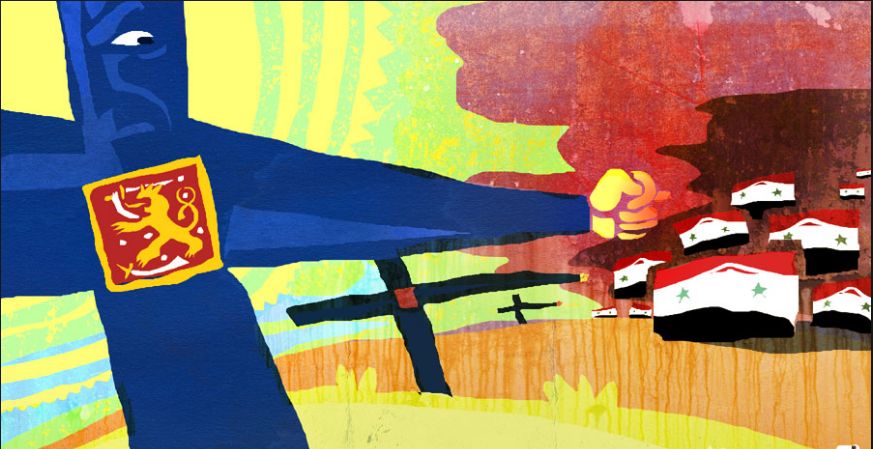Incitement of Hatred
 "True Finns" against refugees.
"True Finns" against refugees.
In April 2012 a controversial statement issued Helena Eronen, the assistant of the Finns Party parliament member J.Hirvisaari, was a focal point for the media. She suggested that all non-Finnish residents should wear distinguishing symbols on their clothing. This idea was originally posted in Eronen’s internet blog, yet the ideas became well publicised. Society regarded this as true incitement of inter-ethnic hatred. The consequence of this scandal was that the author of such radical projections was forced to resign.
In early October, the English-language editor of the blog Migrant Tales Enrique Tessieri said that the Finnish media artificially stir up the situation regarding issues related to the newcomers, actively promoting the views of the ultra-right. He warned journalists that spreading a one-sided and intolerant vision of immigrants can lead to “a society that we could not imagine in our most terrible dreams.
In January-February, 2013, people found out about the large-scale publishing of anti-Semitic material in the free newspaper “Magneettimedia”, which was distributed at the “Karkkaynen” mall in Helsinki.
On July 28, The Finland Times published an article which claimed that the murder of three Israeli yeshiva students, which became a reason for the escalation in Gaza, was committed by Israeli intelligence rather than Hamas.
The Finnish television channel, MTV-3 produced and aired various Russophobic displays directed against the Russians in Finland on many occasions in 2012. In particular the authors focused on Russians purchasing real estate in the Northern Karelia Province. MTV-3 speculated whether the Russian secret service purposefully acquires bases for possible future subversion and spying; another speculative version was whether the mafia was money laundering in Finland. Consequently, after a series of these broadcasts the reported cases of vandalism of houses and flats belonging to Russians escalated in the cities of Lappeenranta, Ruokolahti, Joutseno and Imatra. It is important to note that the channel’s xenophobia is not directed against Russian Federation citizens, but rather against people of a Russian ethnic background.
On October 16, 2014, Finnish nationalists organised a “Night Watch” in Helsinki, which was mainly targeted at immigrants.
On December 6 – Finnish Independence Day – nationalist held a torchlight procession in Helsinki under the slogan “Finland for Finns”. The event was attended by delegations from Sweden, Italy and Germany.
The spread of hate on the Finnish Internet was a big problem even before the coronavirus pandemic. This is stated in report of the Council of Europe published on September 10, 2019. It concluded that racist and offensive language is "common" on the Internet in Finland and is gaining popularity in political discussions. The main targets are asylum seekers and Muslims. However, online “expressions of racism and xenophobia directed against people of African descent, LGBT people and the Jewish community are also common, as are offensive language against the Roma,” the authors said.
Moreover, at the end of 2018, the EU Fundamental Rights Agency found that people of African descent in Finland were the most likely to experience alleged racial harassment and violence out of the 12 community member states surveyed.
According to Finnish Police, a third of municipal decision makers and almost half of deputies of the Finnish Parliament or their aides have become targets of hate speech in 2020 because of their official duties or position. Many of those who participated in the study stated that they have left or are about to leave politics, or at least they are considering it.
Jews continue to be one of the main objects of hatred, although their number in Finland does not exceed 2,500 people. Stickers and posters with anti-Semitic images and messages during 2019-20 were placed on the building of the Helsinki synagogue, in areas with a significant Jewish population and in public facilities. The vandalism ranged from deliberate to apparently accidental, and similar incidents had occurred many times over the previous three years. Some of the anti-Semitic graffiti and stickers claimed to be from the banned Northern Resistance Movement (NRM). The stickers were specifically targeted at members of the Jewish community at Lesbian, Gay, Bisexual, Transgender, Gay and Intersex (LGBTQI+) pride events. Representatives of the Jewish community reported that, despite the available video and photographic evidence of the perpetrators, the police did not make any arrests during the incidents.
The government provided funding to secure a synagogue in Helsinki, but the Central Council of Finnish Jewish Communities said the funding was recently cut in half. Representatives of the Jewish community reported that they feel threatened and are being targeted for persecution because of their beliefs.
Experts also note that public debates about the religious practice of slaughtering animals in relation to kosher products and about non-medical male circumcision have often used direct or veiled anti-Semitic and anti-Muslim statements.


